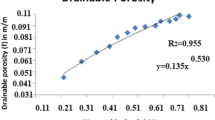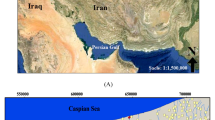Abstract
Drainage design parameters of drain depth and spacing are the pivotal factors affect the drain water quality by radial flow of underground water. In this study, artificial neural network modeling has been employed with Levenberg–Marquardt learning algorithm followed by Sigmoid Axon transfer function to anticipate the temporal changes in shallow groundwater and drain water salinities at various depths and spaces of drain installation. Calibration and validation of the model results were carried out based on data obtained from experimental model with 1.8 m long, 1 m wide, and 1.2 m high. In the model, drains were installed at 20, 40, and 60 cm depths and 60, 90, and 180 cm spaces. The values of error indices of RMSE and SE as well as R2 between measured and simulated shallow groundwater salinities were 5.27 dS/m, 0.12, and 0.96, respectively. These indexes for drain water salinity were obtained 0.72 dS/m, 0.096, and 0.99, respectively. The key results revealed that artificial neural network methodology has a reasonable accuracy on simulating temporal shallow groundwater and drain water salinities in different drain depth and drain spacing.






Similar content being viewed by others
References
Abbasi Maedeh P, Mehrdadi N, Nabi Bidhendi GR, Zare Abyaneh H (2013) Application of artificial neural network to predict total dissolved solids variations in groundwater of Tehran plain, Iran. J Environ Sustain 2(1):10–20
Ayars JE, Christen EW, Hornbuckle JW (2006) Controlled drainage for improved water management in arid regions irrigated agriculture. J Agric Water Manag 86:128–139
Bruton JM, Mcclendon RW, Hoogenboom G (2000) Estimating daily pan evaporation with artificial neural network. J ASCE 43(2):492–496
Deveral JS, Fio JL (1990) Ground-water flow and solute movement to drain laterals, Western San Joaquin Valley, California. J Water Resour Res 27:233–246
Hayat gheybi V (2001) The application of neural networks in the estimation of floodwater of Marg River in Kermanshah province. M.Sc. thesis Civil Hydraulic Structures, Islamic Azad University, Kerman, Iran (in farsi)
Hornbuckle JW, Christen EW, Faulkner RD (2007) Evaluating a multi-level subsurface drainage system for improved drainage water quality. J Agric Water Manag 89:208–216
Hornik K, Stinchcombe M, White H (1989) Multilayer feedforward networks are universal approximators. J Neural Netw 2:359–366
Kannan N (2008) Study of drawdown–drain discharge relationship and its application in design of cost effective subsurface drainage system in Mugogo Swamp, Busogo, Rwanda. J Water Resour Manag 22(8):1113–1125
Landeras G, Ortiz-Barredo A, Lo´pez JJ (2008) Comparison of artificial neural network models and empirical and semi-empirical equations for daily reference evapotranspiration estimation in the Basque Country (Northern Spain). J Agric Water Manag 95:553–565
Malota M, Senzanje A (2015) Modeling mid-span water table depth and drainage discharge dynamics using DRAINMOD 6.1 in a sugarcane field in Pongola, South Africa. J Water Res Comm 41(3):325–334
Masters T (1993) Practical neural network recipes in C++. Academic Press, Sandiego
Nazari B, liaghat A, Parsinejad M, Naseri AA (2008) Optimization of installing depth of subsurface drainage with economic and environmental considerations. Fifth Engineering Workshop of Drainage and Environmental, National Committee of Irrigation and Drainage of Iran, Iran (In farsi)
Nozari H, Liaghat A (2014) Simulation of drainage water quantity and quality using system dynamics. J Irrig Drain Eng. doi:10.1061/(ASCE)IR.1943-4774.0000748
Riad S, Mania G, Bouchaou L, Najjar Y (2004) Rainfall-runoff model using an artificial neural network approach. J Math Comput Model 40:839–846
Rozameijer JC, Visser A, Borren W, Winegram M, van der Velde Y, Klein J, Broers HP (2015) High frequency monitoring of water fluxes and nutrient loads to assess the effects of controlled drainage on water storage and nutrient transport. J Hydrol Earth Syst Sci Discuss 12:6275–6304
Sarangi A, Man Singh Bhattacharya AK, Singh AK (2006) Subsurface drainage performance study using SALTMOD and ANN models. J Agric Water Manag 84(3):240–248
Shakyba M, Liyaghat A, Mirzaee F (2013) The effect of the depth of the water table and discharge of drainage water on the depth and quality of groundwater mixing the output of the in vitro model. J Irrig Drain 7(2):122–132 (In Farsi)
Shao XH, Hou MM, Chen LH, Chang TT, Wang WN (2012) Evaluation of subsurface drainage design based on projection pursuit. J Energy Procedia 16:747–752
Skaggs RW,(1980) DRAINMOD reference report. Methods for design and evaluation of drainage-water management systems for soils with high water tables. USDASCS, South National Technical Center, Fort Worth, Texas. p. 329
Tabari H, Sabziparvar AA, Ahmadi M (2010) Comparison of artificial neural network and multivariate linear regression methods for estimation of daily soil temperature in an arid region. J Springer. doi:10.1007/s00703-010-0110-z
Terz Ö, Keskn ME (2005) Modeling of daily pan evaporation. J Appl Sci 5:368–372
Tiwari P, Goel A (2015) An overview of impact of subsurface drainage project studies on salinity management in developing countries. J Appl Water Sci. doi:10.1007/s13201-015-0329-4
Unal B, Mamak M, Seckin G, Cobaner M (2010) Comparison of an ANN approach with 1-D and 2-D methods for estimating discharge capacity of straight compound channels. J Adv Eng Softw 41:120–129
Wesström I, Joel A, Messing I (2014) Controlled drainage and sub irrigation—a water management option to reduce on-point source pollution from agricultural. J Agric Ecosyst Environ 198:74–82
Zou P, Yang J, Fu J, Liu G, Li D (2010) Artificial neural network and time series models for predicting soil salt and water content. J Agric Water Manag 97(12):2009–2019
Author information
Authors and Affiliations
Corresponding author
Ethics declarations
Conflict of interest
The authors declare that they have no conflict of interest.
Rights and permissions
About this article
Cite this article
Nozari, H., Azadi, S. Experimental evaluation of artificial neural network for predicting drainage water and groundwater salinity at various drain depths and spacing. Neural Comput & Applic 31, 1227–1236 (2019). https://doi.org/10.1007/s00521-017-3155-9
Received:
Accepted:
Published:
Issue Date:
DOI: https://doi.org/10.1007/s00521-017-3155-9




